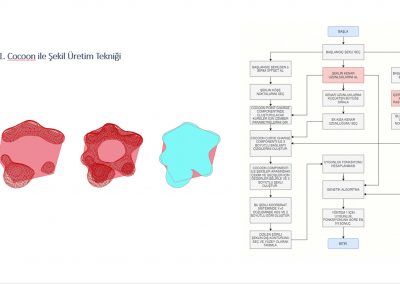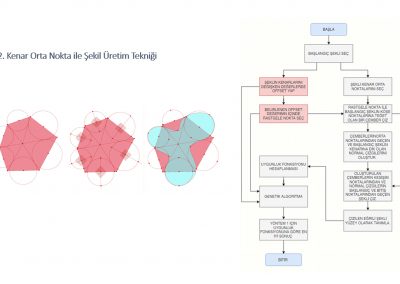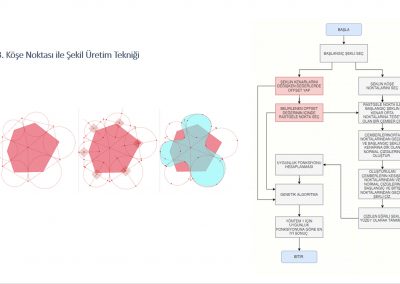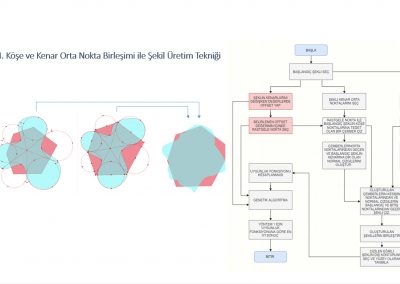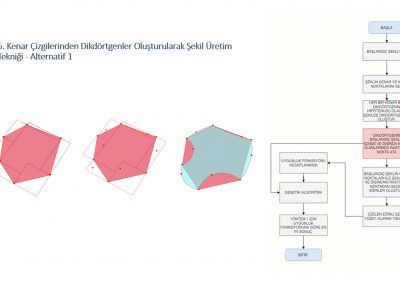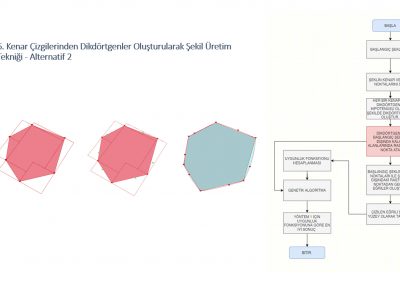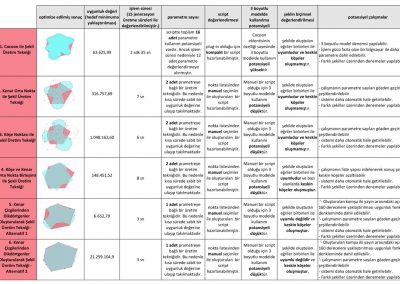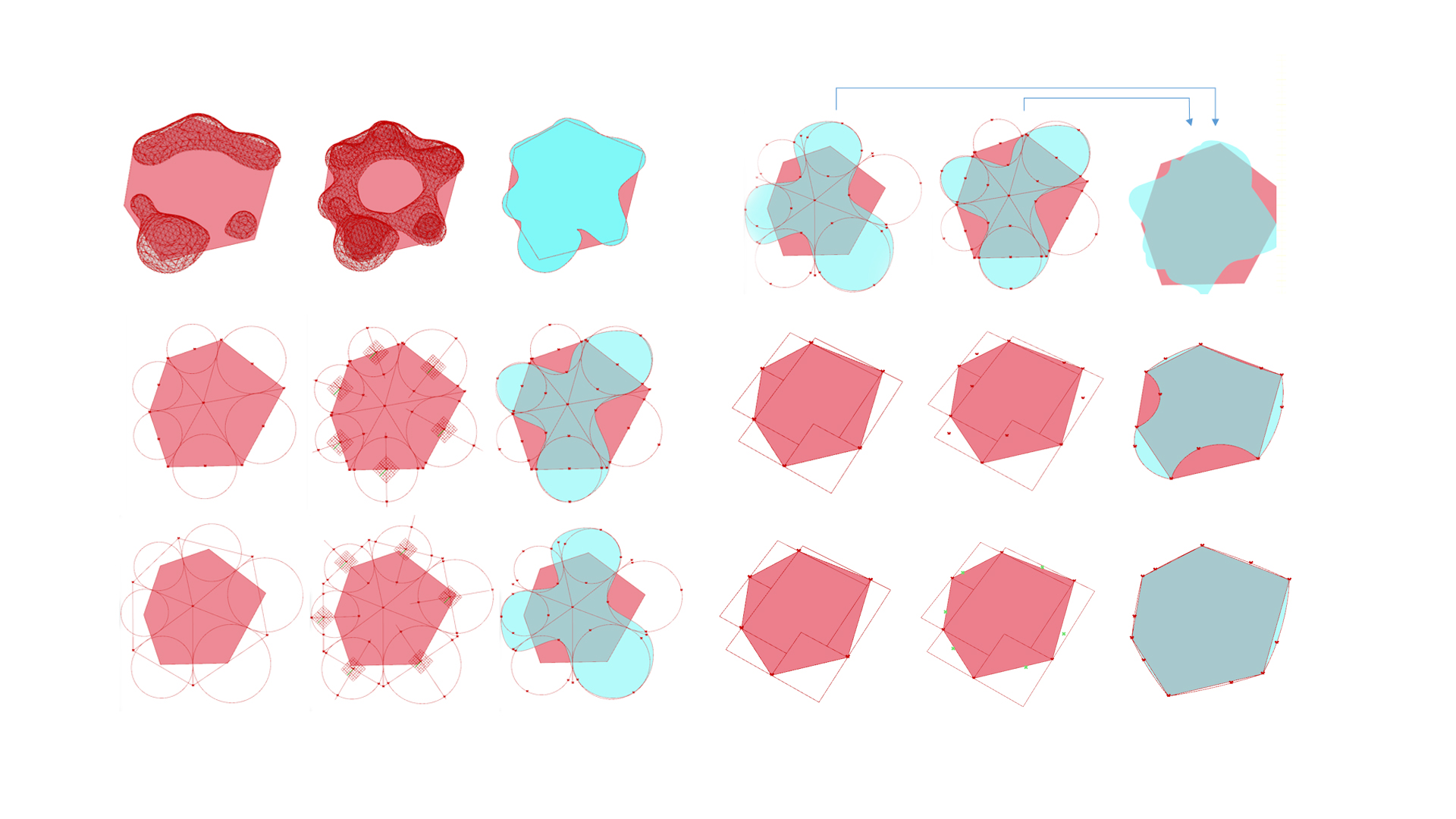
Genetik Algoritmalar Kullanılarak 2 Boyutlu Poligon Şekilleri Eğrili Şekillere Dönüştürme Çalışması
Günümüzde öncelikli olarak mühendislik alanı araştırma konularından birisi olan şekil tanıma çalışmaları, teknoloji ve mimarlığın ara kesitinde de bir tür araştırma konusu haline gelmiştir. Şekil tanıma yöntemleri, mimarlıkta kullanılan 3 boyutlu model oluşturma programları arasında dosya geçiş problemlerinde kullanılabilme potansiyeline sahiptir. Bu potansiyel bağlamında yaygın kullanılan Maya, 3ds Max, SketchUp ve Rhino programları incelenmiştir. İlgili programların kullanıcı topluluklarında sıkça karşılaşılan poligon modelin NURBS modele dönüşüm sorularının çokluğu, bu probleminin önemini göstermektedir. Yapılan araştırmanın motivasyonu, mimarlık alanında sıklıkla karşılaşılan bu problemin çözülmesi için bir ön çalışma yapmaktır. Yapılan çalışmanın amacı, 3 boyutlu model dönüşümlerini 2 boyuta indirgeyerek, poligon şeklin eğrili şekillere dönüşümü için farklı teknikler geliştirmek ve teknikler arasında karşılaştırmalı analiz yapmaktır. Çalışma kapsamında, Rhino Grasshopper programı kullanılarak 6 farklı şekil üretim tekniği geliştirilmiştir. Çalışmada geliştirilen üretim tekniklerinden elde edilen, çeşitli parametrelere bağlı şekiller genetik algoritma yardımıyla optimize edilmiştir. Galapagos eklentisi ile yapılan optimizasyonda, başlangıç ve sonuç şeklin kesişim alanları üzerine kurgulanan bir uygunluk fonksiyonu formülü oluşturulmuştur. Makalede sırasıyla, literatür taraması, uygunluk fonksiyonu ve üretim tekniklerinin açıklanması, tekniklerin karşılaştırmalı olarak değerlendirilmesi bölümleri yer almaktadır. Çalışma sonunda yapılan değerlendirmeye göre Cocoon Grasshopper eklentisi ile şekil üretim tekniği diğer üretim tekniklerine oranla daha fazla potansiyele sahiptir. Bu tekniğin seçilme nedeni, uygunluk fonksiyonu yönünden başarılı bir son ürün üretmesi, genotip ve fenotip çeşitliliğinin fazla olması, 3 boyutlu modelde uygulanma potansiyelinin diğer yöntemlere oranla fazla olmasıdır. Bu çalışmanın geliştirilmesi ile birlikte, 3 boyutlu poligon modelden NURBS modele dönüşüm çalışmaları yapılabilir. Böylece bu çalışmanın da motivasyonu olan, mimarlık alanında kullanılan programlar arasında dosya geçişlerindeki zorluklar ortadan kaldırabilir.
A Study on Conversion Work from 2D Polygon Shapes to Curved Shapes with Using Genetic Algorithms
Shape recognition studies, which are primarily one of the research topics in the field of engineering today, have also become a kind of research topic in the intersection of technology and architecture. Shape recognition methods have the potential to be used in file transition problems between 3D modeling programs used in architecture. In the context of this potential, the widely used Maya, 3ds Max, SketchUp and Rhino programs have been examined. The multitude of questions about the conversion of the polygon model to the NURBS model, which is frequently encountered in the user communities of the related programs, shows the importance of this problem. The motivation of the research is to make a preliminary study to solve this problem, which is frequently encountered in the field of architecture. The aim of the study is to reduce 3D model transformations to 2 dimensions, to develop different techniques for transforming polygon shapes to curved shapes and to make a comparative analysis between techniques. Within the scope of the study, 6 different shape production techniques were developed using the Rhino Grasshopper program. The shapes obtained from the production techniques developed in the study, depending on various parameters, were optimized with the help of genetic algorithms. In the optimization made with the Galapagos plugin, a fitness function formula was created based on the intersection areas of the initial and final shape. In the article, there are sections of literature review, a fitness function and explanation of production techniques, and comparative evaluation of techniques. According to the evaluation made at the end of the study, the shape production technique with the Cocoon Grasshopper plugin has more potential than other production techniques. The reason for choosing this technique is that it produces a successful end product in terms of fitness function, the genotype and phenotype diversity is high, and its application potential in the 3D model is higher than other methods. With the development of this study, conversion studies can be made from the 3D polygon model to the NURBS model. Thus, the difficulties in transferring files between programs used in the field of architecture, which is also the motivation of this study, can be eliminated.
© 2021 Istanbul Technical University Graduate School, Department of Informatics, Architectural Design Computing Program. All Rights Reserved
